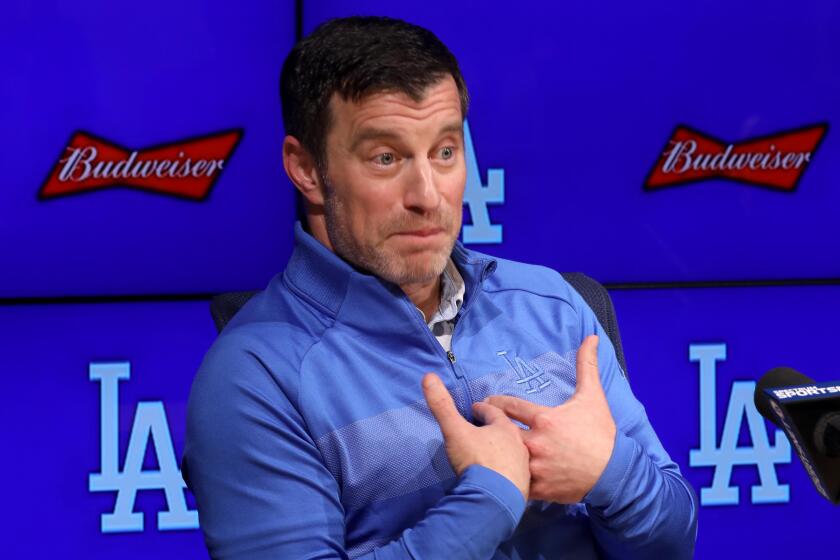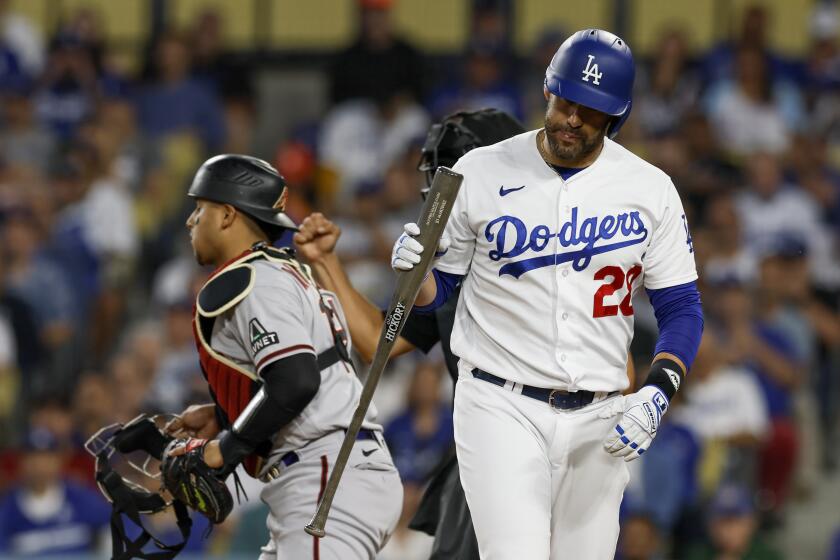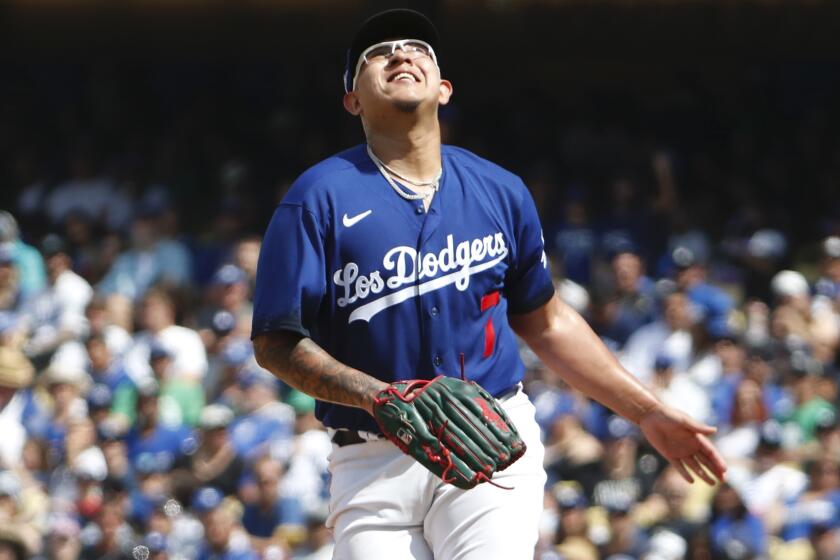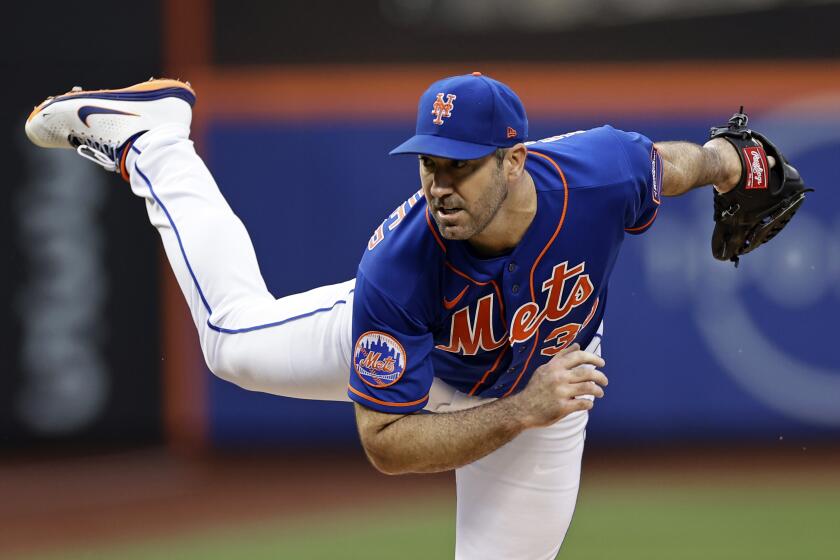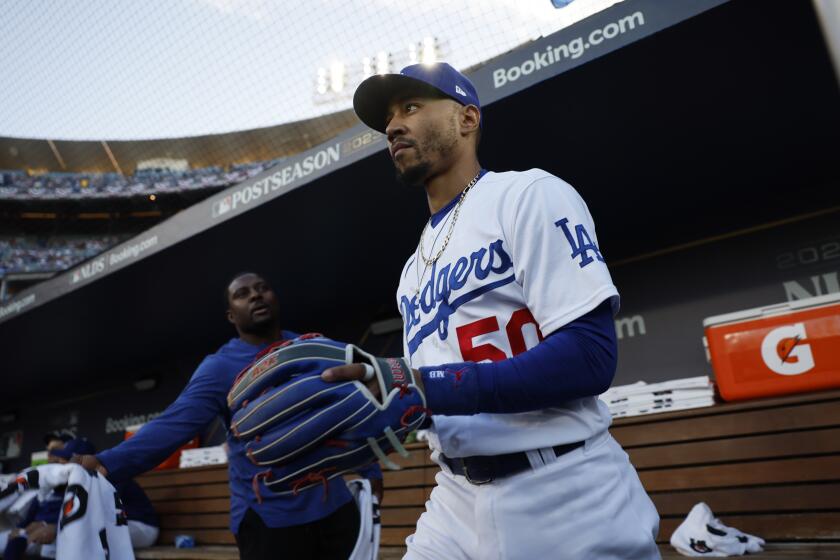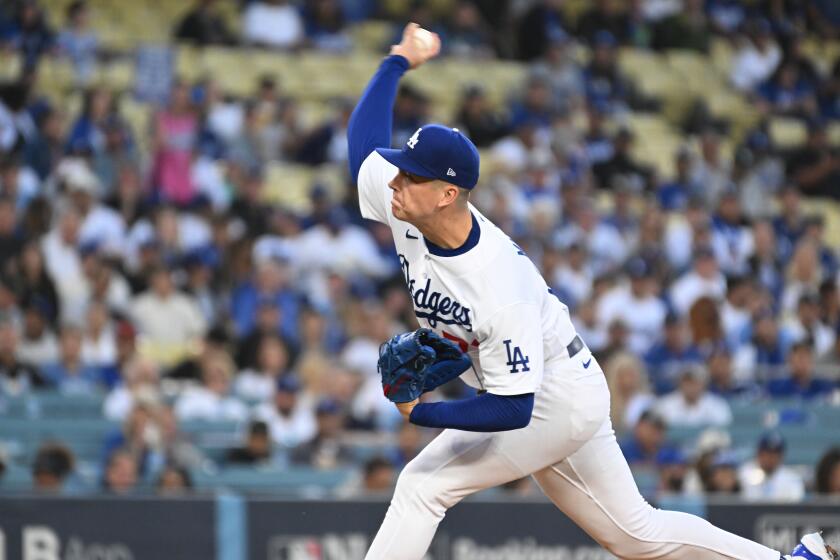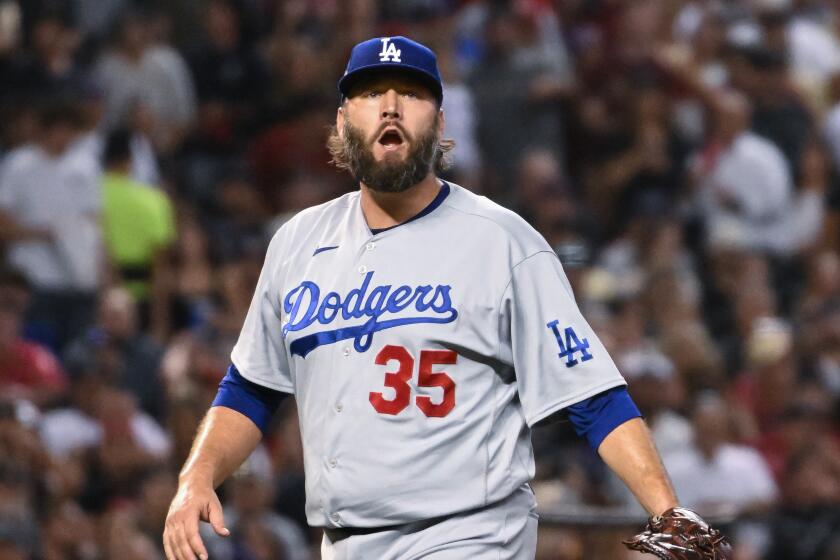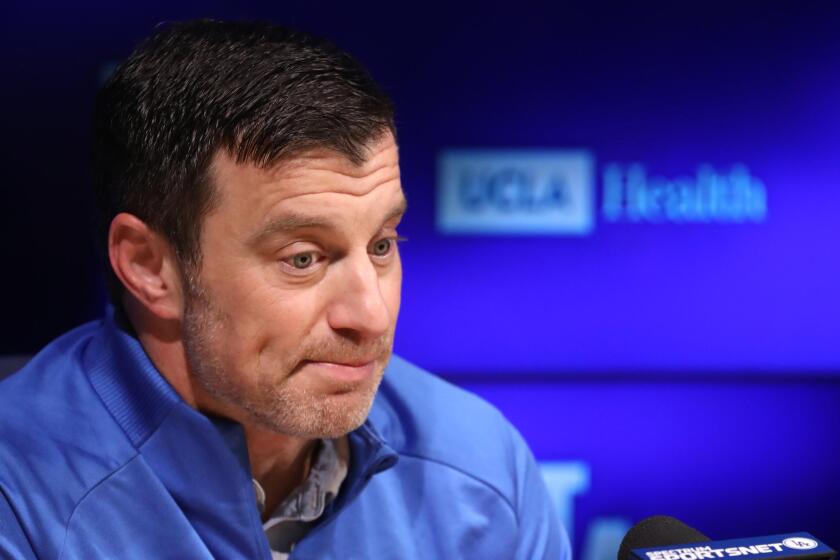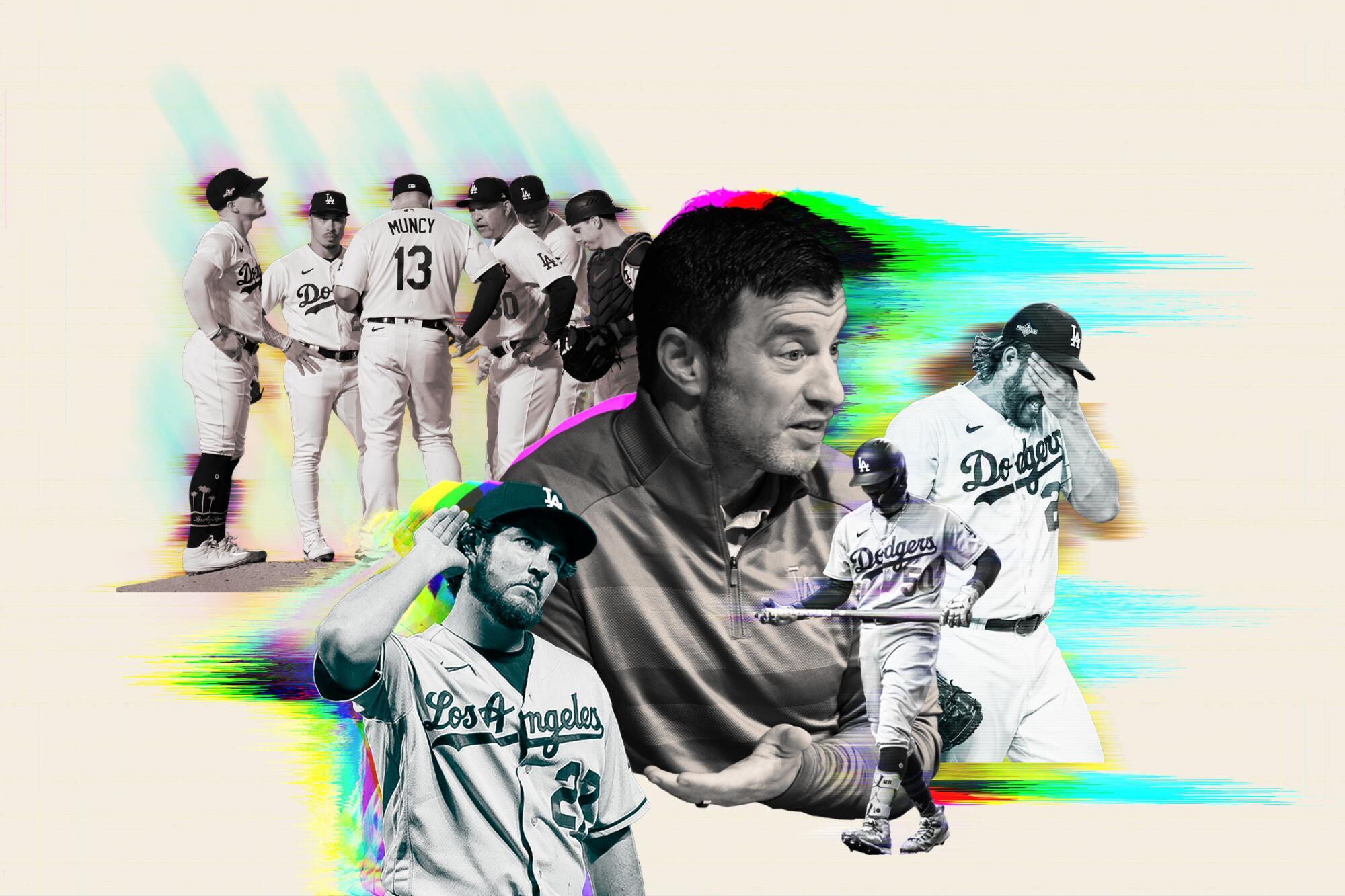
Wearing a plaid sports coat and self-assured grin, Andrew Friedman ascended the Dodger Stadium podium in February 2021 like a conquering hero, the reigning monarch of a Dodger-blue empire that finally captured baseball’s throne.
Four months earlier, the Dodgers had won a long-awaited World Series in the pandemic-shortened 2020 season — the first for Friedman as president of baseball operations and for his bosses, Mark Walter and the rest of Guggenheim Baseball Management, as the well-funded owners.
Then, in a blockbuster move, the Dodgers seemingly won the winter too — adding reigning National League Cy Young Award-winner Trevor Bauer to an already loaded roster.
After a 32-year wait for one title, more championships suddenly seemed poised to follow.
The birth of a dynasty, many pundits predicted, was unfolding. And as Friedman introduced Bauer at a news conference in Dodger Stadium that afternoon, he couldn’t help but smile.
“It’s about doing everything we can to go out and defend a title,” Friedman declared. “And hopefully, we can do it with fans in the stands in Dodger Stadium.”
Dodgers president of baseball operations Andrew Friedman hosted the media Tuesday and couldn’t provide an answer to the same question every year.
Three seasons later, those fans are back but still waiting.
For another World Series title. For an October run that ends in triumph, not anguish. For that potential dynasty to be realized before it’s too late.
Ever since that 2020 season, the Dodgers have suffered a series of missteps, miscalculations and misfortunes in their hunt for another championship. They’ve squandered three straight 100-win seasons with three early, unexpected playoff exits and are 3-10 in their last 13 postseason games.
The culprits have ranged from subpar starting pitching to poor situational hitting, ill-timed offensive slumps to inexplicable superstar failings. Each setback has been more disheartening than the last, culminating in this month’s three-game sweep against the Arizona Diamondbacks in the division series.
And, in a stark contrast to the triumphant start to 2021, Friedman’s end-of-season news conference last week struck a far different note.
“Our goal was to win 11 games in October and we didn’t win one,” he said. “So we need to figure out what we can do differently, and how to go about it.”
A lack of starting pitching
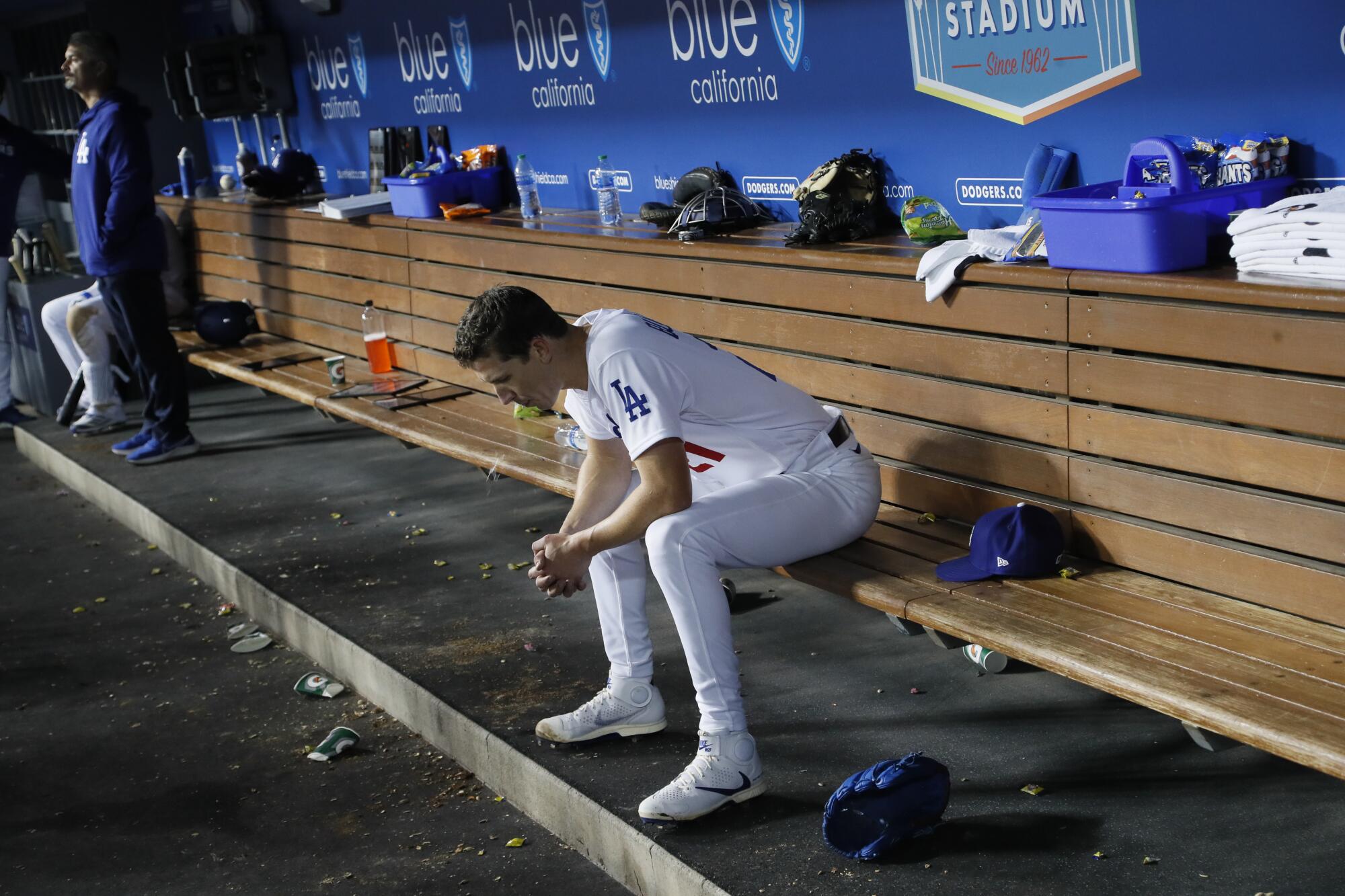
It was Walker Buehler on short rest in 2021. Tyler Anderson on a short leash in 2022. And, short on other appealing options, Lance Lynn in this year’s latest playoff blunder.
Those have been the Dodgers’ starting pitchers in their last three eliminations. An overworked ace. An undervalued veteran. An outmatched deadline acquisition.
The starting rotation is not the only reason the team has failed to win another title. But it sticks out as an appropriate place, when reviewing the last three postseasons, for any postmortem to begin.
“The biggest issue was the pitching,” one rival scout said. “It’s amazing how it just fell apart on them.”
The Dodgers haven’t had bad pitching staffs the last three years. In 2021 and 2022, they led the majors in ERA. Though they slipped to 13th this season, they ranked second after the All-Star break.
The Dodgers, after another playoff exit, are left to wonder how they could be so good in the regular season, then disappear when the pressure ratchets up.
What has happened repeatedly, however, is crippling attrition with the starters.
The Dodgers once fielded deep rotations with frontline stars such as Buehler, Clayton Kershaw and Hyun-Jin Ryu, as well as reliable veterans including Kenta Maeda, Rich Hill and Alex Wood.
Between 2017 and 2020, the team not only led the majors in rotation earned-run average and walks plus hits per inning pitched, but also ranked fifth in strikeouts and had the eight-most starts of six or more innings.
At almost every turn in those postseasons — which included three pennants and the 2020 title — they had an established arm to turn to when needed.
And the arrival of Bauer was supposed to only enhance their arsenal.
“We feel we have seven proven major league starters,” Friedman boasted the day Bauer arrived, joining a 2021 rotation that included Kershaw, Buehler, Julio Urías, Tony Gonsolin, Dustin May and David Price.
Alas, a series of problems on and off the field slowly befell the Dodgers instead, starting an annual cycle that has left the rotation short on arms.
In 2021, Bauer went on administrative leave amid sexual assault allegations that July, all but ending his Dodgers career after just 17 starts. Kershaw and May suffered season-ending elbow injuries. Gonsolin and Price were too inconsistent for prominent playoff roles.
As the Dodgers begin another postseason push, it’s hard to find references to Julio Urías at Dodger Stadium. But his absence will be felt.
The club still won 106 games, entering the playoffs as World Series favorites with a starting trio of Buehler, Urías and blockbuster trade acquisition Max Scherzer.
But even that wasn’t enough. In the NLDS, Buehler started on short rest in Game 4 and Scherzer closed out Game 5 in relief. In the championship series, the Dodgers’ plan to use Urías in the same swingman role he excelled at in 2020 backfired.
It all ended, infamously, when Scherzer was unable to pitch in Game 6 of the NLCS because of arm fatigue, forcing Buehler to start on short rest again in the Dodgers’ elimination against the 88-win Atlanta Braves.
The last two seasons have followed similar scripts, only with inaction from the front office looming as another underlying culprit.
In 2022, Bauer never returned, Scherzer departed as a free agent, Buehler went down with an elbow injury that eventually required Tommy John surgery, and May and Gonsolin were limited physically in the playoffs.
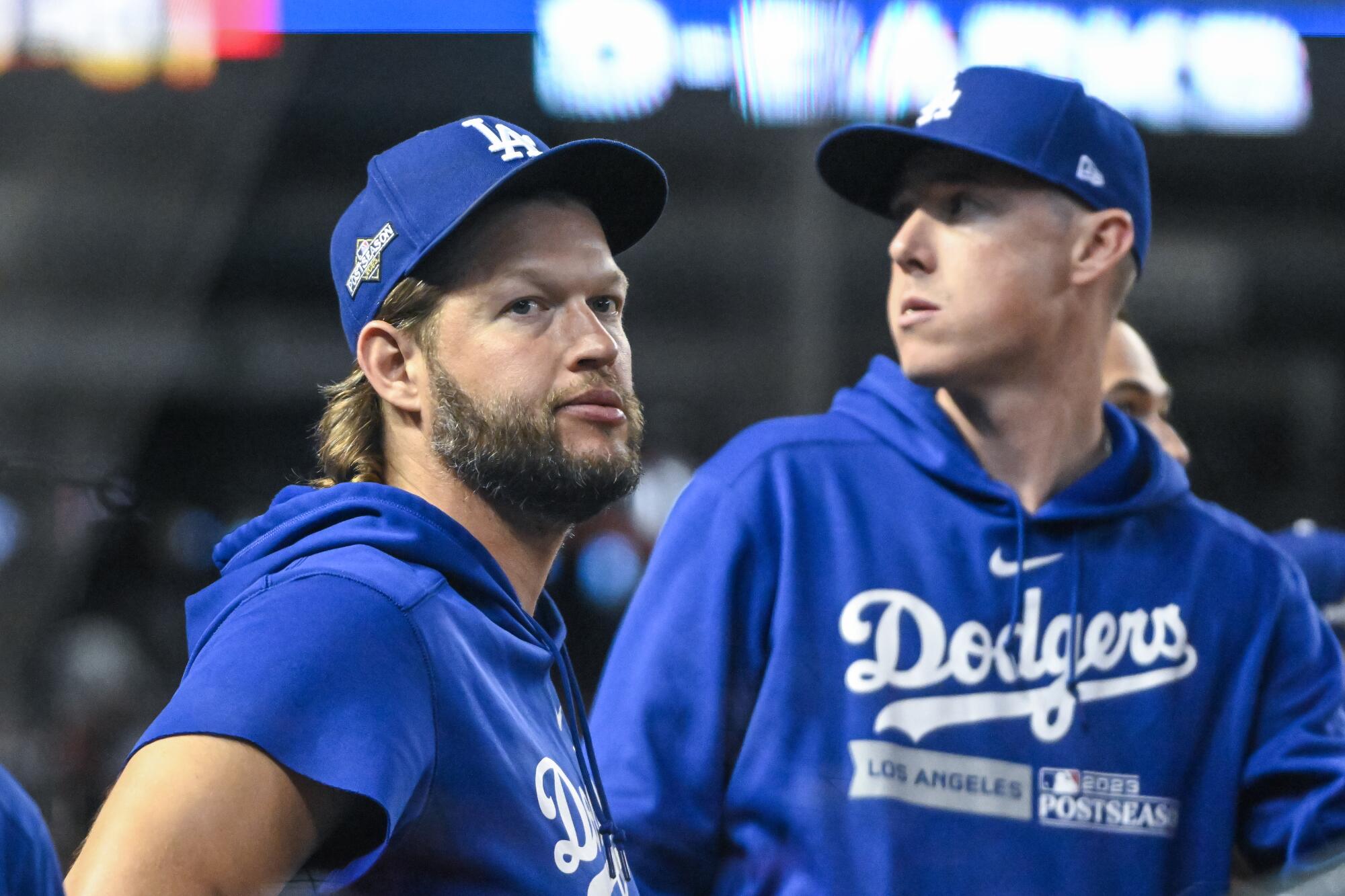
The resulting playoff rotation: Urías, Kershaw and … Anderson, a low-cost offseason signing who actually provided the best start of the group in Game 4 of the NLDS against the San Diego Padres, but got a quick hook after five scoreless innings on a night the bullpen blew a late lead.
This year, May and Gonsolin suffered season-ending elbow injuries, Kershaw battled a shoulder ailment that hampered his stuff and, in one last unforeseen twist, Urías also landed on administrative leave following a September arrest on suspicion of domestic violence.
The resulting playoff rotation: a banged-up Kershaw, rookie Bobby Miller and … Lynn, another low-cost, short-term addition who was arguably left in too long against the Diamondbacks in Game 3, giving up a playoff-record four homers in an inning after surrendering the most in the majors this season.
There are two lenses to view the pitching problems.
On one hand, as Friedman noted last week, most teams that lose the majority of their starting rotations don’t make the playoffs, let alone win 100 games.
To the Dodgers’ credit, they’ve been able to call upon a cast of rookie contributors, extract production from undervalued veterans and cobble together strong overall pitching numbers, nonetheless.
Yet, teams with exorbitant payrolls like the Dodgers, who have paid luxury-tax penalties the last three years, aren’t supposed to simply sneak into the playoffs, either.
For another deep October run, the Dodgers seemingly have needed another top-end arm, with a clear hole in their rotation ever since Bauer was exiled, Scherzer left town and Buehler got hurt.
At various points they seemingly had opportunities to add one, including deadline discussions for Pablo López in 2022, a free-agency pursuit of Justin Verlander last offseason and a nixed deal for Eduardo Rodríguez at this year’s deadline.
The team failed to complete any such impact acquisition, however, settling instead for modest alternatives Anderson and Andrew Heaney in 2022, and Lynn and Noah Syndergaard this year.
The Dodgers knew they needed to make some moves to improve the roster, but with nearly all of their intended trade targets they encountered issues.
That was enough for the team to maintain decent regular-season production, including the second-best starting pitching ERA in the majors the last two years.
But, since 2022, the rotation also ranks just 18th in innings pitched, 17th in strikeouts per nine innings and has only the 12th-most six-inning starts — shortcomings that, in October, have left the margin of error for the rest of the team precariously thin.
“Is this a roster that’s built for the regular season? Or built for the postseason?” the scout said. “I think that’s a very, very fair question to ask.”
A lapse of timely offense
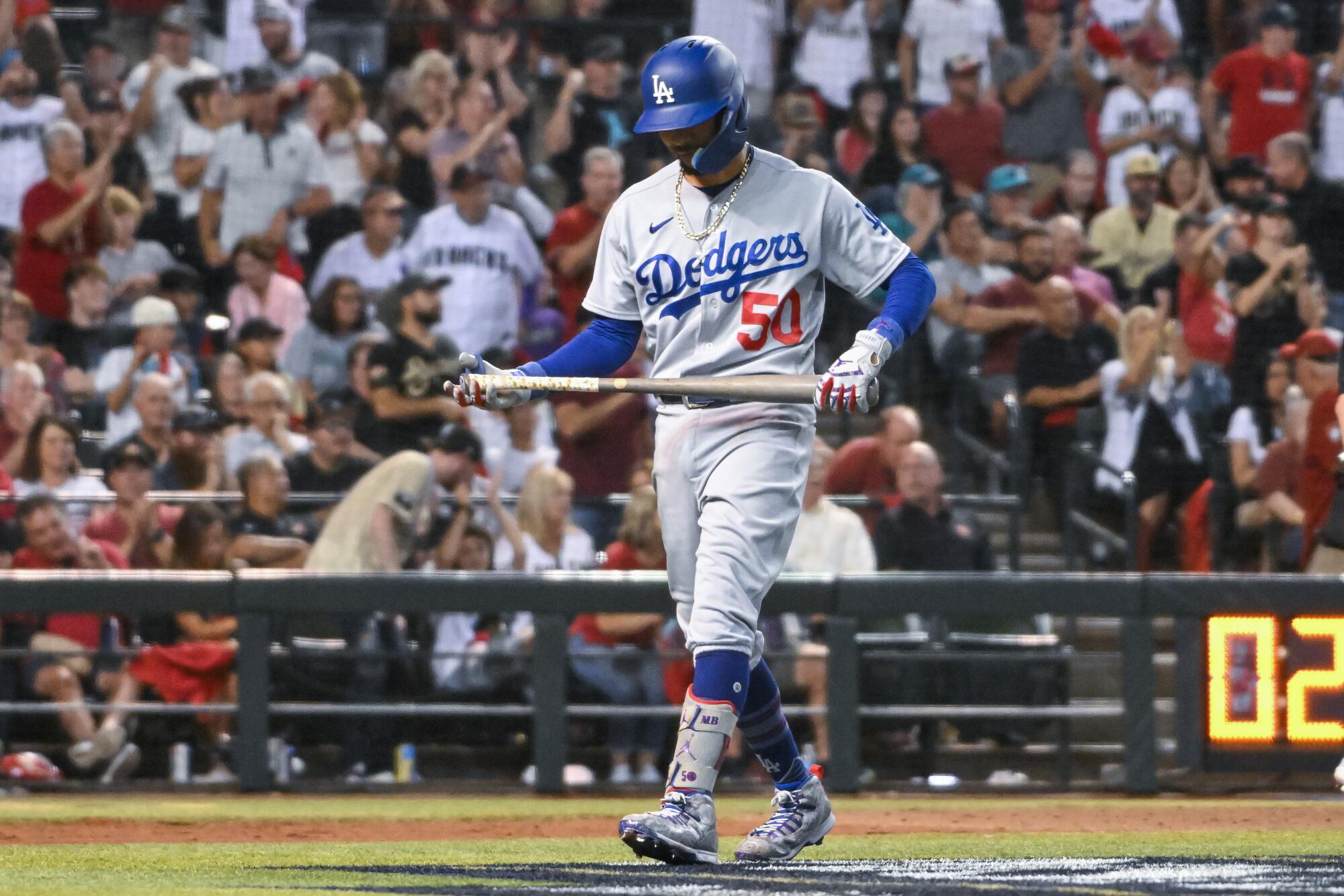
Max Muncy sighed at the question, once again unable to explain a dilemma that has baffled the Dodgers over the last three years.
Why has the offense struggled so much in recent postseasons?
“Well, we’ve tried to dig into this a bunch,” Muncy said during an appearance on the Foul Territory podcast last week. “About why things are so different for us in the postseason.”
The elephant in the room, especially this year: the performance of Mookie Betts, Freddie Freeman and the other big stars.
Betts went hitless in 11 NLDS at-bats and is three for his last 38 in the playoffs. Freeman was just one for 10 and like Betts squandered several key situations.
And despite flashes from Will Smith, J.D. Martinez and Kiké Hernández, no one else in the lineup bailed them out.
“Those are our guys, two great players,” manager Dave Roberts said following the series. “It’s one of those things that, in baseball, I don’t have an answer, I really don’t.”
It doesn’t mean the Dodgers haven’t looked.
In regular-season play since 2021, the Dodgers lead the majors in runs scored (5.3 per game) and on-base percentage (.335). They are second in home runs (698) and slugging percentage (.442). They are sixth in batting average (.253) and third in walk-to-strikeout rate (0.45).
Come the postseason, however, those numbers tank across the board. They’ve averaged just 3.5 runs per game. Their batting/OBP/slugging is a poor .231/.295/.372. Their home run rate has gone down and their strikeout rate has ticked up.
Most teams find it harder to hit in the playoffs. But the Dodgers’ struggles have been particularly dire, especially when factoring in their .212 average with runners in scoring position — almost 30 points below the league-average postseason mark in that span.
Mookie Betts and Freddie Freeman are in their prime and they still can’t help the Dodgers win a playoff game. That doesn’t bode well for Andrew Friedman.
“Our offense didn’t perform as well as they could have,” Friedman said. “It’s not what we would have expected.”
Like the pitching staff, the lineup has undergone significant changes in that span, losing All-Star mainstays Corey Seager, Trea Turner, Justin Turner and Cody Bellinger in free agency.
And as with the pitching staff, the Dodgers have addressed most of the holes with lower-risk, lower-cost additions, the surprise arrival of Freeman last year representing their only long-term, big-name lineup acquisition since the 2020 World Series.
Yet, the inability to hit has become an annual shock — especially with Freeman and Betts spearheading the batting order.
“[Other teams] aren’t just rolling over, saying, ‘You guys can win,’” Betts said. “When you’re in the postseason, man, you gotta play well. We have not.”
While no single answer explains it, there are several theories as to why.
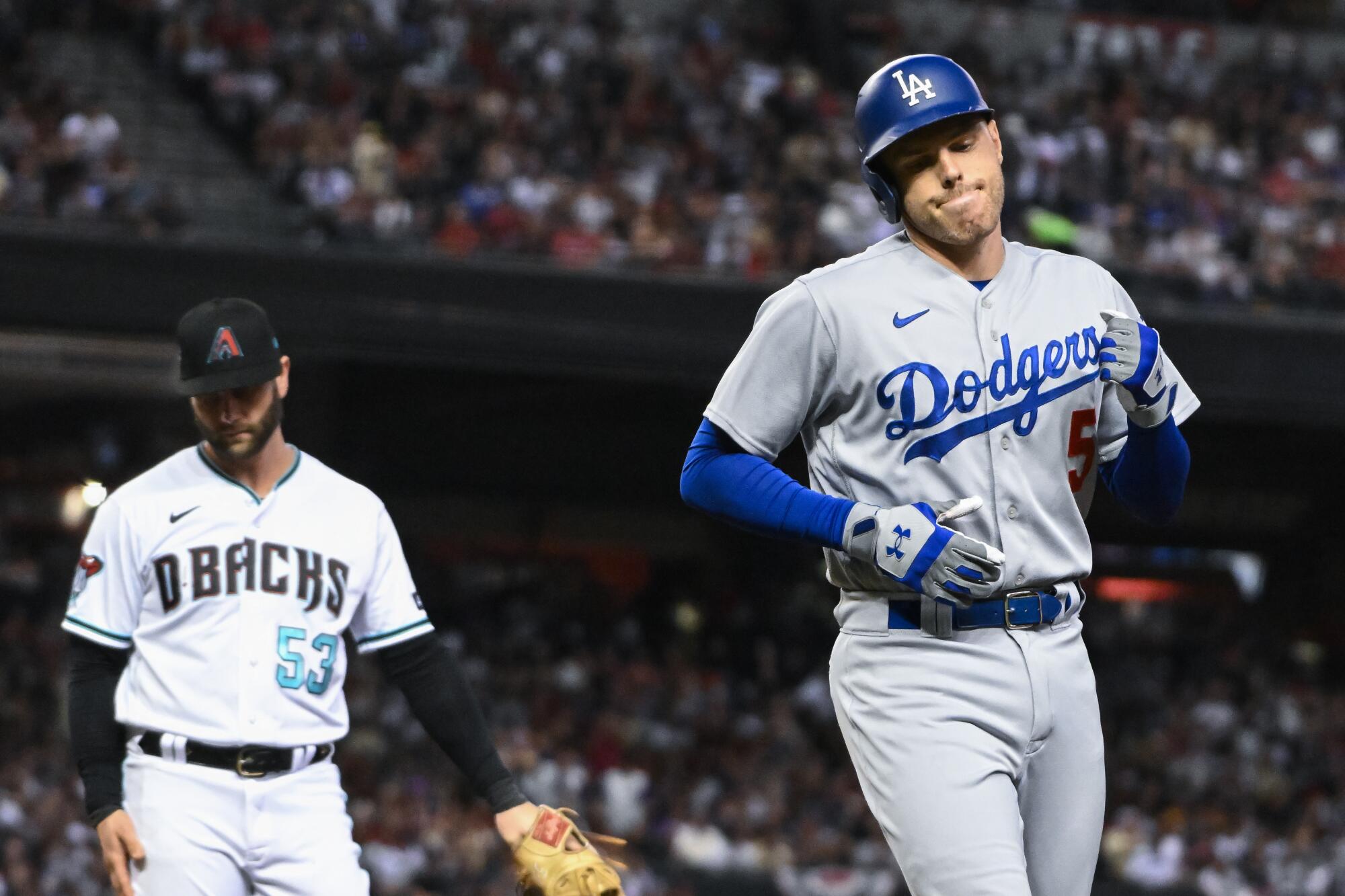
In the regular season, the Dodgers are one of baseball’s most selective lineups. This year they had the 10th-lowest swing percentage and fifth-lowest chase rate. As usual, they were proficient at working hitters’ counts and waiting for a hittable mistake.
Some rival evaluators credit the Dodgers’ highly-touted scouting and analytics departments. Over a 162-game sample, perhaps no club is better at identifying pitchers’ tendencies and executing its game plans.
“When it’s June 17 and the other team has just flown cross-country and is playing their 19th game in 20 days, nobody can match them,” one evaluator said.
The postseason, however, presents a different environment.
The caliber of pitching rises. So does the level of opponents’ preparation. Many of the advantages the Dodgers enjoy during their six months of regular-season play suddenly disappear.
And in the face of that heightened challenge, their hitters repeatedly have faltered.
“Our offense didn’t perform as well as they could have,” Friedman said. “It’s not what we would have expected.”
The Dodgers might have the best bullpen in the majors, but the Arizona Diamondbacks are beating them because of the options their starters give them.
Sometimes, the Dodgers seemingly struggle to adjust to pitchers who alter their tendencies.
The Braves did so in 2020, when the Dodgers had to come back from a 3-1 hole in the NLCS, and 2021, limiting L.A. to four runs or fewer four times in six games.
The Padres followed suit last year, holding the Dodgers to 12 runs in four games.
This year Arizona attempted a similar approach. Merrill Kelly attacked left-handed hitters with more cutters, rather than his trademark changeup, in a Game 1 rout. Zac Gallen stayed away from his best pitch, his curveball, until late in his Game 2 start, most notably surprising Freeman with three straight breaking balls for a key strikeout.
While the Dodgers have downplayed that dynamic — such a strategy, after all, also requires opponents to go away from their strengths — Muncy still noted the difference after Game 1 this year.
“In the regular season, they pitch you a certain way,” he said. “Then they flip the script when they get to the postseason.”
Another potential factor, some scouts have noticed, is opponents’ ability to take advantage of the Dodgers’ plate discipline.
Instead of risking early-count fastballs over the plate, pitchers have at times gotten ahead with breaking balls that start outside the zone (prompting Dodgers hitters to lay off) before breaking back in for called strikes.
“Other teams are smart enough to adjust their approach,” a scout said.
According to Muncy, the Dodgers have taken note — especially as more free-swinging teams have achieved October success in recent years.
“The teams that are making it to the World Series, they’re going up there and they’re getting their swings off,” Muncy told Foul Territory, “whereas we’re being too disciplined.”
It’s a delicate balance. When the Dodgers did expand the zone and chase more in this year’s NLDS — often, when facing a deficit bestowed upon them by ineffective starting pitching — Roberts bemoaned their quality of at-bats.
Conversely, when the team got fastballs over the plate, it failed to capitalize.
“We had opportunities,” Roberts said. “But when you get opportunities you’ve got to cash in.”
Another offseason of lingering questions
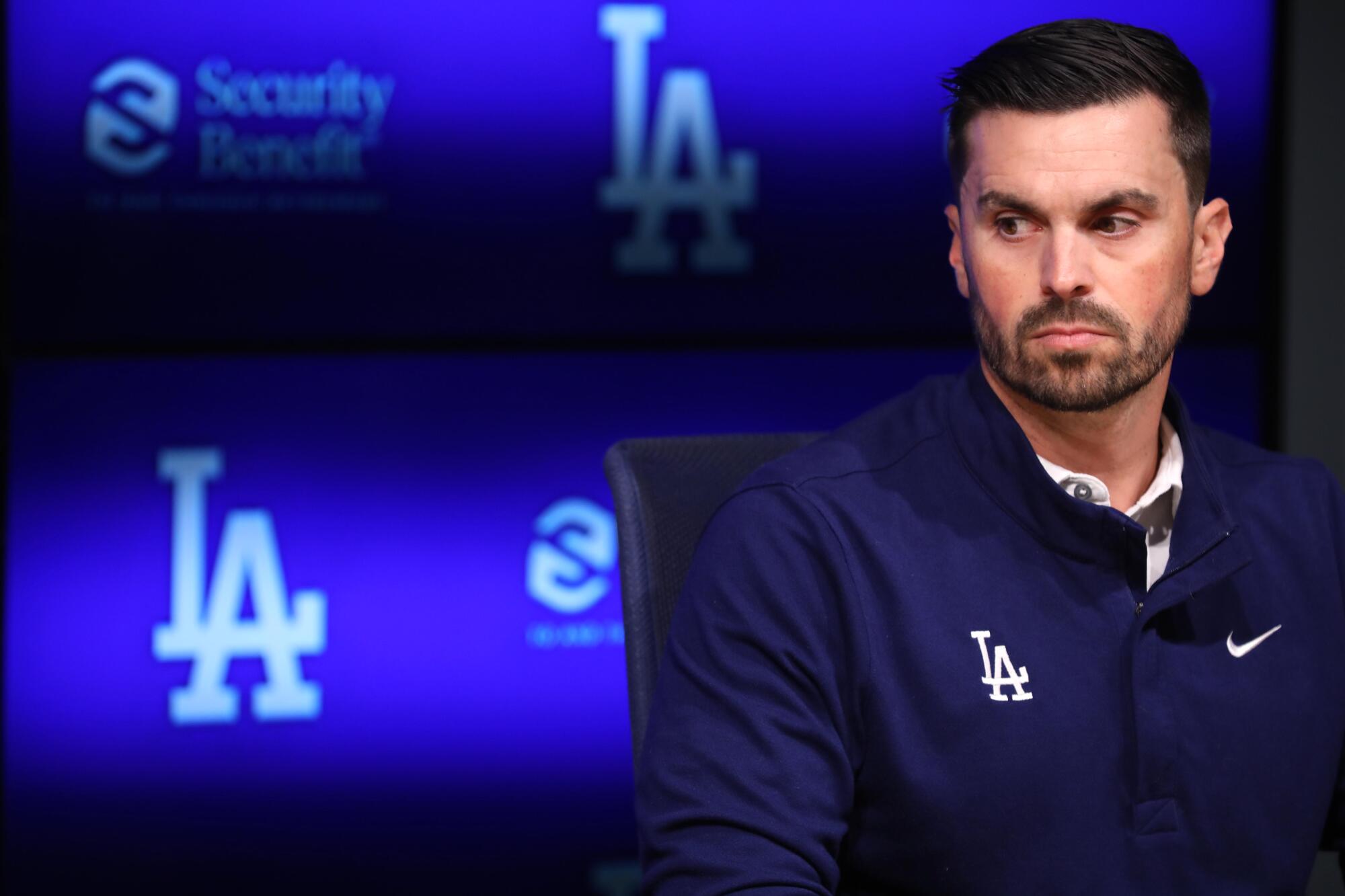
Like last year, Friedman decried the Dodgers’ October shortcomings as an “organizational failure” — but also cautioned against any “overreactions” amid their continued regular season success.
“We’re all disappointed, to a person,” general manager Brandon Gomes echoed. “But to do an overcorrection is also not helpful in that way.”
At the crux of that process is a baseball dynamic that’s easy to debate but difficult to determine: Are some teams better suited for the postseason? And, if so, are the Dodgers a club that needs to reimagine its approach with playoff success, and not just regular-season dominance, in mind?
For now, the answers appear to be no to both.
Plenty of reasons explain why the Dodgers lost to the Diamondbacks in the NLDS. Having five days off because of the playoff format isn’t one of them.
Friedman didn’t agree with the former premise, pushing back on the idea some players are inherently better in October than others.
“People should really go through and look at each guy, year to year, the noise and variance year to year,” he said. “It’s just not that easy to be like, ‘Oh, let’s just get the guy who is going to perform in October.’ Because if it was, I promise you we would do that.”
Although he took accountability for not better reinforcing the pitching staff, Friedman also disputed the notion that the club could have easily acquired more impact postseason arms.
“We would like guys to go seven innings, pitch really well and be able to go to the best two guys in the bullpen,” he said. “Question is, how many of them are there? … There aren’t many guys going six or seven in postseason games, anecdotally, as I look around.”
Verlander, López and Jordan Montgomery (another player included in Dodgers trade discussions leading up to this year’s deadline) are all counter examples, each providing the kind of playoff dominance this year the Dodgers too often have lacked.
Getting any of them, however, likely would have required overpaying, either in salary or prospect capital, by the Dodgers’ estimation — an antithesis of Friedman’s approach to team construction, except for the absolute highest caliber of superstar additions.
The Dodgers again were eliminated early in the postseason, but Andrew Friedman says manager Dave Roberts and his staff will return.
Instead, the Dodgers have put an emphasis on future financial flexibility, funneling prospects up from the minors and trying to qualify for the crapshoot of the playoffs as often as possible, crossing their fingers that their number will turn up more times than not.
In the regular season, that method continues to thrive. But come the postseason, too many roster decisions have backfired. Too many game plans have fizzled. And too many star players have failed to shine.
Three years removed from their only championship of this generation, the Dodgers’ window of contention certainly remains open.
But their chances of establishing a dynasty — one that seemed almost preordained just a few years ago — is increasingly at risk of being slammed shut.
“In the regular season, obviously, there’s a lot to be proud of,” Friedman said. “But then obviously, with our ultimate goal, we came up incredibly short.”
More to Read
Are you a true-blue fan?
Get our Dodgers Dugout newsletter for insights, news and much more.
You may occasionally receive promotional content from the Los Angeles Times.

